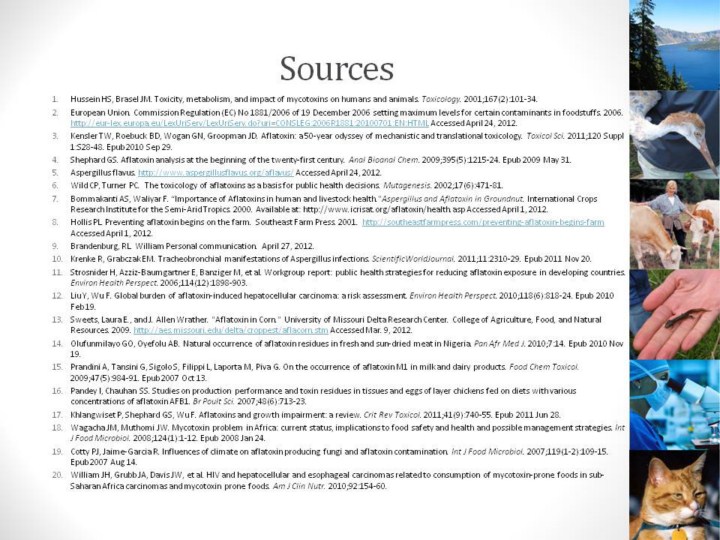| front |1 |2 |3 |4 |5 |6 |7 |8 |9 |10 |11 |12 |13 |14 |15 |16 |17 |18 |19 |20 |21 |22 |23 |24 |25 |26 |27 |28 |29 |30 |31 |review |
 |
1.Hussein
HS, Brasel JM. Toxicity, metabolism, and impact of mycotoxins on humans
and animals.
Toxicology.
2001;167(2):101-34.
2.European
Union. Commission Regulation (EC) No 1881/2006 of 19 December 2006
setting maximum levels for certain contaminants in foodstuffs. 2006.
http://eur-lex.europa.eu/LexUriServ/LexUriServ.do?uri=CONSLEG:2006R1881:20100701:EN:HTML
Accessed April 24, 2012.
3.Kensler
TW, Roebuck BD, Wogan GN, Groopman JD. Aflatoxin: a 50-year odyssey of
mechanistic and translational toxicology.
Toxicol Sci.
2011;120 Suppl 1:S28-48. Epub 2010 Sep 29.
4.Shephard
GS. Aflatoxin analysis at the beginning of the twenty-first century.
Anal Bioanal Chem.
2009;395(5):1215-24. Epub 2009 May 31.
6.Wild
CP, Turner PC. The toxicology of aflatoxins as a basis for public
health decisions.
Mutagenesis.
2002;17(6):471-81.
7.Bommakanti
AS, Waliyar F. “Importance of Aflatoxins in human and livestock health."Aspergillus
and Aflatoxin in Groundnut.
International Crops Research Institute for the Semi-Arid Tropics. 2000.
Available at: http://www.icrisat.org/aflatoxin/health.asp Accessed April
1, 2012.
8.Hollis
PL. Preventing aflatoxin begins on the farm. Southeast Farm Press.
2001.
http://southeastfarmpress.com/preventing-aflatoxin-begins-farm
Accessed April 1, 2012.
9.Brandenburg,
RL. William Personal communication. April 27, 2012.
10.Krenke
R, Grabczak EM. Tracheobronchial manifestations of Aspergillus
infections.
ScientificWorldJournal.
2011;11:2310-29. Epub 2011 Nov 20.
11.Strosnider
H, Azziz-Baumgartner E, Banziger M, et al. Workgroup report: public
health strategies for reducing aflatoxin exposure in developing
countries.
Environ Health Perspect.
2006;114(12):1898-903.
12.Liu
Y, Wu F. Global burden of aflatoxin-induced hepatocellular carcinoma: a
risk assessment.
Environ Health Perspect.
2010;118(6):818-24. Epub 2010 Feb 19.
13.Sweets,
Laura E., and J. Allen Wrather. "Aflatoxin in Corn." University of
Missouri Delta Research Center. College of Agriculture, Food, and
Natural Resources. 2009.
http://aes.missouri.edu/delta/croppest/aflacorn.stm
Accessed Mar. 9, 2012.
14.Olufunmilayo
GO, Oyefolu AB. Natural occurrence of aflatoxin residues in fresh and
sun-dried meat in Nigeria.
Pan Afr Med J.
2010;7:14. Epub 2010 Nov 19.
15.Prandini
A, Tansini G, Sigolo S, Filippi L, Laporta M, Piva G. On the occurrence
of aflatoxin M1 in milk and dairy products.
Food Chem Toxicol.
2009;47(5):984-91. Epub 2007 Oct 13.
16.Pandey
I, Chauhan SS. Studies on production performance and toxin residues in
tissues and eggs of layer chickens fed on diets with various
concentrations of aflatoxin AFB1.
Br Poult Sci.
2007;48(6):713-23.
17.Khlangwiset
P, Shephard GS, Wu F. Aflatoxins and growth impairment: a review.
Crit Rev Toxicol.
2011;41(9):740-55. Epub 2011 Jun 28.
18.Wagacha
JM, Muthomi JW. Mycotoxin problem in Africa: current status,
implications to food safety and health and possible management
strategies.
Int J Food Microbiol.
2008;124(1):1-12. Epub 2008 Jan 24.
19.Cotty
PJ, Jaime-Garcia R. Influences of climate on aflatoxin producing fungi
and aflatoxin contamination.
Int J Food Microbiol.
2007;119(1-2):109-15. Epub 2007 Aug 14.
20.William
JH, Grubb JA, Davis JW, et al. HIV and hepatocellular and esophageal
carcinomas related to consumption of mycotoxin-prone foods in
sub-Saharan Africa carcinomas and mycotoxin prone foods.
Am J Clin Nutr.
2010;92:154-60.
|